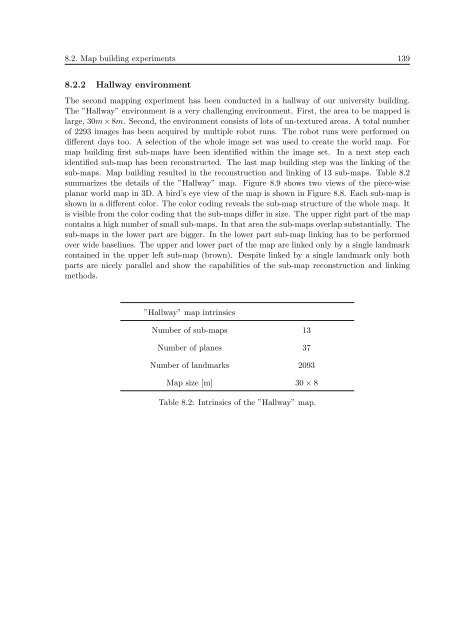PHD Thesis - Institute for Computer Graphics and Vision - Graz ...
PHD Thesis - Institute for Computer Graphics and Vision - Graz ...
PHD Thesis - Institute for Computer Graphics and Vision - Graz ...
Create successful ePaper yourself
Turn your PDF publications into a flip-book with our unique Google optimized e-Paper software.
8.2. Map building experiments 139<br />
8.2.2 Hallway environment<br />
The second mapping experiment has been conducted in a hallway of our university building.<br />
The ”Hallway” environment is a very challenging environment. First, the area to be mapped is<br />
large, 30m × 8m. Second, the environment consists of lots of un-textured areas. A total number<br />
of 2293 images has been acquired by multiple robot runs. The robot runs were per<strong>for</strong>med on<br />
different days too. A selection of the whole image set was used to create the world map. For<br />
map building first sub-maps have been identified within the image set. In a next step each<br />
identified sub-map has been reconstructed. The last map building step was the linking of the<br />
sub-maps. Map building resulted in the reconstruction <strong>and</strong> linking of 13 sub-maps. Table 8.2<br />
summarizes the details of the ”Hallway” map. Figure 8.9 shows two views of the piece-wise<br />
planar world map in 3D. A bird’s eye view of the map is shown in Figure 8.8. Each sub-map is<br />
shown in a different color. The color coding reveals the sub-map structure of the whole map. It<br />
is visible from the color coding that the sub-maps differ in size. The upper right part of the map<br />
contains a high number of small sub-maps. In that area the sub-maps overlap substantially. The<br />
sub-maps in the lower part are bigger. In the lower part sub-map linking has to be per<strong>for</strong>med<br />
over wide baselines. The upper <strong>and</strong> lower part of the map are linked only by a single l<strong>and</strong>mark<br />
contained in the upper left sub-map (brown). Despite linked by a single l<strong>and</strong>mark only both<br />
parts are nicely parallel <strong>and</strong> show the capabilities of the sub-map reconstruction <strong>and</strong> linking<br />
methods.<br />
”Hallway” map intrinsics<br />
Number of sub-maps 13<br />
Number of planes 37<br />
Number of l<strong>and</strong>marks 2093<br />
Map size [m] 30 × 8<br />
Table 8.2: Intrinsics of the ”Hallway” map.















